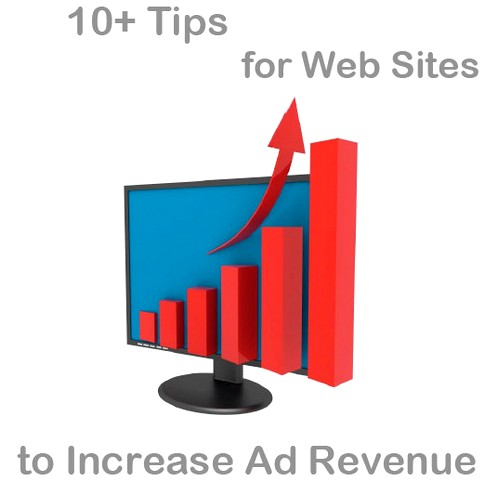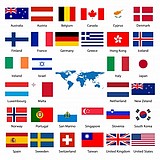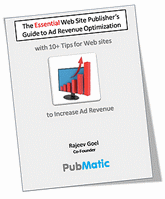 Here is a company, a rare one I must say, that not only has spent serious time trying to understand and match my needs with their specific services, but has had enough integrity and courage to openly recognize its strengths and weaknesses and to provide me with the very best monetization advice I have received from a supplier in a long time.
Rajeev Goel, CEO and Co-founder of Pubmatic, a company that specializes in optimizing ad network serving for web sites has just released an essential guide to ad revenue optimization, after having looked for a long time at what other the opportunity points to be leveraged in the fast-changing ad serving and optimization marketplace. He writes:
Here is a company, a rare one I must say, that not only has spent serious time trying to understand and match my needs with their specific services, but has had enough integrity and courage to openly recognize its strengths and weaknesses and to provide me with the very best monetization advice I have received from a supplier in a long time.
Rajeev Goel, CEO and Co-founder of Pubmatic, a company that specializes in optimizing ad network serving for web sites has just released an essential guide to ad revenue optimization, after having looked for a long time at what other the opportunity points to be leveraged in the fast-changing ad serving and optimization marketplace. He writes: "Never before have Web site publishers like you had such an accessible opportunity to improve the performance of your advertising; ad serving costs are down and the explosion of ad networks has created an opportunity to get highest possible price for your inventory."Here the details:
The Essential Web Site Publisher’s Guide to Ad Revenue Optimization
by Rajeev GoelIntroduction
 The vast majority of web sites today are not monetizing their advertising to their fullest potential.
In the U.S. alone that accounts for billions of dollars per year that could have been made with improved advertising performance. While there is no panacea to improve all of the underperforming parts of all the web sites with one swift fix, savvy web site publishers can take steps to improve their advertising performance, which will directly increase the ad revenue they make from their web site.
I created this guide for the same reason I started PubMatic - to help web site publishers make more money.
Web site publishers are content creators first and foremost, and creating good content takes a lot of time and energy. Improving a website's advertising revenue can also take a lot of time and energy.
PubMatic offers a solution that simultaneously saves web site publisher's time while increasing their advertising revenue. In very simple terms, PubMatic helps manage web site publisher's relationships with ad networks, and uses a sophisticated, constantly improving algorithm to ensure the best performing advertisement is shown at the highest price paid to the publisher. PubMatic's service and technology improves the ad serving decisions for web site publishers; and that is perhaps the most complex and revenue effecting part of online advertising (which of course we make simple for web site publishers!).
However, there are still many other improvements a web site publisher can handle on their own hands without the help of PubMatic.
If you are a web site publisher that wants to increase your ad revenue, following the tips in this guide will help you achieve that goal. I intend on updating this guide, so please check back often or subscribe to PubMatic's mailing list for all the latest news from us.
The vast majority of web sites today are not monetizing their advertising to their fullest potential.
In the U.S. alone that accounts for billions of dollars per year that could have been made with improved advertising performance. While there is no panacea to improve all of the underperforming parts of all the web sites with one swift fix, savvy web site publishers can take steps to improve their advertising performance, which will directly increase the ad revenue they make from their web site.
I created this guide for the same reason I started PubMatic - to help web site publishers make more money.
Web site publishers are content creators first and foremost, and creating good content takes a lot of time and energy. Improving a website's advertising revenue can also take a lot of time and energy.
PubMatic offers a solution that simultaneously saves web site publisher's time while increasing their advertising revenue. In very simple terms, PubMatic helps manage web site publisher's relationships with ad networks, and uses a sophisticated, constantly improving algorithm to ensure the best performing advertisement is shown at the highest price paid to the publisher. PubMatic's service and technology improves the ad serving decisions for web site publishers; and that is perhaps the most complex and revenue effecting part of online advertising (which of course we make simple for web site publishers!).
However, there are still many other improvements a web site publisher can handle on their own hands without the help of PubMatic.
If you are a web site publisher that wants to increase your ad revenue, following the tips in this guide will help you achieve that goal. I intend on updating this guide, so please check back often or subscribe to PubMatic's mailing list for all the latest news from us.
Optimization Tips
1) Diversify of Your Ad Networks
 What: All ad networks are not equal. In fact, most ad networks differ in seemingly subtle ways that are actually quite varied: targeting approaches, geographic focus, vertical focus, mix of advertisers, and ad campaign targets (branding, clicks, conversion) are just a few examples. Them result is that different ad networks will determine relevancy of ads relative to a publisher’s web page differently.
Take the popular Web site SeatGuru as an example. SeatGuru maintains seat maps for every major airline’s fleet of airplanes, and provides information about the comfort and amenities available in each seat. One ad network might conduct page-level contextual analysis and determine that the page is about airline travel, and therefore, show an airline ad.
Another ad network might conduct site-level demographic or behavioral targeting and determine that the site appeals to moderate to high-income business travelers, and show a life insurance ad. A third ad network might be looking at the users who views the site, rather than the site itself, and identify a given user as an in-market auto buyer and show that user a Lexus ad.
What: All ad networks are not equal. In fact, most ad networks differ in seemingly subtle ways that are actually quite varied: targeting approaches, geographic focus, vertical focus, mix of advertisers, and ad campaign targets (branding, clicks, conversion) are just a few examples. Them result is that different ad networks will determine relevancy of ads relative to a publisher’s web page differently.
Take the popular Web site SeatGuru as an example. SeatGuru maintains seat maps for every major airline’s fleet of airplanes, and provides information about the comfort and amenities available in each seat. One ad network might conduct page-level contextual analysis and determine that the page is about airline travel, and therefore, show an airline ad.
Another ad network might conduct site-level demographic or behavioral targeting and determine that the site appeals to moderate to high-income business travelers, and show a life insurance ad. A third ad network might be looking at the users who views the site, rather than the site itself, and identify a given user as an in-market auto buyer and show that user a Lexus ad.
Benefits: By diversifying your mix of ad networks, you as the publisher, can determine what the most valuable aspect of your audience and content is, and therefore, determine the best mix of ad networks that can monetize your audience. Travel ads might be a source of high-income advertisements, or alternatively the audience that is interested in travel might be high-income and therefore can be sold higher value financial products with related financial ads.
What to do next: Look at the mix of ad networks you are using, and classify them along the lines of behavioral, contextual, and demographic targeting capabilities. Depending on the size of your site, look to get one to three ad networks in each area and identify which targeting mechanism works the best for your site.
2) Implement a Segmentation Strategy
 What: Smaller Web sites that are more targeted in content and are niche-oriented tend to have a higher eCPM than large, broad Web sites (The June 2008 PubMatic AdPrice Index reveals small Web sites had an average eCPM of $1.14 vs. 0.21 for large Web site; visit www.PubMatic.com/AdPriceIndex for definition of sizes).
The reason for this is that advertising on these smaller Web sites have a more targeted audience, and therefore, they typically perform better for advertisers than broad Web sites, and so advertisers are willing to pay a higher rate.
So what can you do if you are the owner of a large, broad Web site like WashingtonPost.com?
You can carve your large Web site into a collection of smaller Web sites. By making your large Web site appear like a bunch of small Web sites, you can get the benefit of large Web site scale along with higher advertising rates.
Doing this is easier than it might seem. For example, if you have a Web site that covers a variety of subjects, you may have a navigation bar that includes News, Politics, Opinions, Local, Sports, Arts & Living, and a City Guide. Instead of creating one 728 X 90 ad tag to go across the top of every page on the site, create six of them instead – one for each navigation area on the Web site.
Once that has been done ad networks can better target your Web site’s ad inventory. Callaway can show ads only in the Sports section of the Web site while American Express can show ads only in
the Arts & Living section of the Web site.
You can extend this strategy even further by carving up each of the six areas into smaller areas (Men’s sports vs. Women’s sports, for example).
What: Smaller Web sites that are more targeted in content and are niche-oriented tend to have a higher eCPM than large, broad Web sites (The June 2008 PubMatic AdPrice Index reveals small Web sites had an average eCPM of $1.14 vs. 0.21 for large Web site; visit www.PubMatic.com/AdPriceIndex for definition of sizes).
The reason for this is that advertising on these smaller Web sites have a more targeted audience, and therefore, they typically perform better for advertisers than broad Web sites, and so advertisers are willing to pay a higher rate.
So what can you do if you are the owner of a large, broad Web site like WashingtonPost.com?
You can carve your large Web site into a collection of smaller Web sites. By making your large Web site appear like a bunch of small Web sites, you can get the benefit of large Web site scale along with higher advertising rates.
Doing this is easier than it might seem. For example, if you have a Web site that covers a variety of subjects, you may have a navigation bar that includes News, Politics, Opinions, Local, Sports, Arts & Living, and a City Guide. Instead of creating one 728 X 90 ad tag to go across the top of every page on the site, create six of them instead – one for each navigation area on the Web site.
Once that has been done ad networks can better target your Web site’s ad inventory. Callaway can show ads only in the Sports section of the Web site while American Express can show ads only in
the Arts & Living section of the Web site.
You can extend this strategy even further by carving up each of the six areas into smaller areas (Men’s sports vs. Women’s sports, for example).
Benefits: Smaller Web sites enjoy ad rates that are up to three times as high as large Web sites. You can significantly raise your monetization rates if you can present a more targeted advertising opportunity to the advertiser. And you can do this by limiting the scope of a single ad tag to the most relevant areas possible.
What to do next: Check out the navigational areas of your Web site, and use that as the basis for carving up your large, broad site into a collection of smaller sites. Create one set of ad tags for each smaller area of your site, and use those ad tags with each of your ad networks to get more targeted advertising.
3) Monetize International Traffic
 What: For a typical U.S. web site, 30-40% of the web site’s traffic comes from outside of the U.S. We all know the Web is global, but on top of that, English is often times the language of the Web in foreign countries. For example, the vast majority of Web users in India are visiting English language Web sites, which means your content and services on your U.S. based Web site may be readily consumed by a Web surfer in India. The same is true in many parts of Southeast Asia, Africa, and parts of Europe.
On top of this strong foreign contingent on many U.S. Web sites, the weak U.S. economy and dollar can lead to higher monetization rates outside of the U.S. The slowdown in the U.S. economy has lead to a drop in ad rates in the U.S. (visit www.PubMatic.com/AdPriceIndex for monthly averages) and the weakness of the U.S. dollar makes it relatively cheaper for foreign advertisers to buy U.S. ad inventory.
What: For a typical U.S. web site, 30-40% of the web site’s traffic comes from outside of the U.S. We all know the Web is global, but on top of that, English is often times the language of the Web in foreign countries. For example, the vast majority of Web users in India are visiting English language Web sites, which means your content and services on your U.S. based Web site may be readily consumed by a Web surfer in India. The same is true in many parts of Southeast Asia, Africa, and parts of Europe.
On top of this strong foreign contingent on many U.S. Web sites, the weak U.S. economy and dollar can lead to higher monetization rates outside of the U.S. The slowdown in the U.S. economy has lead to a drop in ad rates in the U.S. (visit www.PubMatic.com/AdPriceIndex for monthly averages) and the weakness of the U.S. dollar makes it relatively cheaper for foreign advertisers to buy U.S. ad inventory.
Benefits: As a result of the significant foreign readership of a typical U.S. Web site, the drop in U.S. ad rates, and the weak US dollar, monetization rates for the 30-40% of foreign traffic on a U.S. Web site can be higher than that of U.S. traffic, resulting in up to half of a Web site’s revenues based on foreign visitors. This foreign traffic is often overlooked as a source of revenue for U.S. Web sites. If you’re not making a significant stream of revenue from your foreign visitors, it is time to re-evaluate your monetization strategy.
What to do next: Check your server logs or Google Analytics reports to identify your top 5-7 geographies outside of the U.S. You will likely be surprised by the amount of foreign traffic. Then determine if your current ad networks can monetize inventory in these geographies. You need an ad network that can reach advertisers in these foreign countries. A U.S. ad network will often default (show blank or empty ads) to visitors from foreign countries, and you typically have no way to know this because you’re sitting in the U.S. and won’t see the default ads! Check if your ad networks have a sales office in the foreign country. If not, do a bit of research to find an appropriate ad network in that country and start working with them right away.
4) Monetize Every Impression
 What: Nothing frustrates a publisher more than a default (empty or blank) ad. Defaults occur when an ad network does not have an ad to show to a user on your site. Web site publishers leave an estimated $1 billion on the table annually as a result of default ads.
There are two main problems that cause this:
• Problem 1: Not having an ad to show. A network runs out of ads for your site, they have reached a frequency cap, or they don’t have ads for the geography of the user. This means you get a $0.00 eCPM.
• Problem 2: When an ad network does default. That means they are not reselling that impression to the highest paying ad network. This problem is just as bad; publishers often setup static daisy chains of ad networks based on historical pricing data in case one ad network in the chain defaults. With a static chain, there is no way to ensure that the highest paying ad network will fill the impression.
How big of a problem is this?
In a study conducted by PubMatic, we found that on average ad networks default 56% of the time, and can default as much as 87% of the time. That’s over half of a publisher’s ad inventory! This is an important one to get right.
The solution is a dynamic marketplace in which default ad impressions are collected and then routed to the highest paying ad network.
What: Nothing frustrates a publisher more than a default (empty or blank) ad. Defaults occur when an ad network does not have an ad to show to a user on your site. Web site publishers leave an estimated $1 billion on the table annually as a result of default ads.
There are two main problems that cause this:
• Problem 1: Not having an ad to show. A network runs out of ads for your site, they have reached a frequency cap, or they don’t have ads for the geography of the user. This means you get a $0.00 eCPM.
• Problem 2: When an ad network does default. That means they are not reselling that impression to the highest paying ad network. This problem is just as bad; publishers often setup static daisy chains of ad networks based on historical pricing data in case one ad network in the chain defaults. With a static chain, there is no way to ensure that the highest paying ad network will fill the impression.
How big of a problem is this?
In a study conducted by PubMatic, we found that on average ad networks default 56% of the time, and can default as much as 87% of the time. That’s over half of a publisher’s ad inventory! This is an important one to get right.
The solution is a dynamic marketplace in which default ad impressions are collected and then routed to the highest paying ad network.
Benefits: A solution that both eliminates defaults and ensures that the impression is sold to the highest possible ad buyer can add 30-50% to a publisher’s revenue base. The key to the solution is detecting when a default happens, then re-selling that ad impression to ensure that the sale is dynamic, and not through a pre-determined or static daisy chain of ad networks.
What to do next: See how often your ad networks are defaulting. If it is more than 10% of the time, consider a dynamic default optimization solution. The only known solution is one that PubMatic provides (learn more at PubMatic.com/news).
5) Sell New Inventory
 What: Consider selling new ad units on your Web site that can be incremental to your existing ad revenues. There are numerous ad units that you may not already be selling, such as page takeovers, in text ads, or pop-ups.
Of course, you don't want to annoy your user base but at the same time most users realize that your wonderful content is paid for via advertising. As long as you stick to ad units that your users have seen
before, the annoyance factor can be minimized.
What: Consider selling new ad units on your Web site that can be incremental to your existing ad revenues. There are numerous ad units that you may not already be selling, such as page takeovers, in text ads, or pop-ups.
Of course, you don't want to annoy your user base but at the same time most users realize that your wonderful content is paid for via advertising. As long as you stick to ad units that your users have seen
before, the annoyance factor can be minimized.
Benefits: New ad units can lead to entirely new revenue streams. For example, in text ads can pay $1 CPMs and up, as can page takeovers. This is new revenue that is almost entirely additive to your Web site. Moreover, you might find that these new ad units are so beneficial that you can remove some of your existing ad units. Best of all, trying out these new ad units won't cost you any money as you can leave your existing ad units in place.
What to do next: Take some notes for the next week as you surf around the Web. Write down any new ad units you see that you aren't currently using on your Web site. For example, I saw a page takeover on the Wall Street Journal's Web site for the first time last week (courtesy of new owner Rupert Murdoch). Once you've got a short list, find ad networks that provide these new ad units (your existing ad network partners might provide some of these) and get them up and running. And don't try them all out at once - rotate them through one at a time, and see what performs the best for you. Be open with your readers and let them know that you're testing new ad options to bring them more of the content they love, and they will probably help you in the process.
6) Call Your Ad Network Representative
 What: Despite all of the automation in the online ad industry, there is still a lot of manual work that is done to sell ads on a Web site. Media buyers need to know what inventory they can secure from publishers, what the characteristics of that inventory are, in terms of content and audience, and how long that inventory will be available to them.
By calling your ad network representative, you can better understand how they target ads to your site and you can better inform them about what is unique about your content and audience. When a new ad campaign comes in, you and your site will be on the top of their mind in terms of where to run that ad campaign.
What: Despite all of the automation in the online ad industry, there is still a lot of manual work that is done to sell ads on a Web site. Media buyers need to know what inventory they can secure from publishers, what the characteristics of that inventory are, in terms of content and audience, and how long that inventory will be available to them.
By calling your ad network representative, you can better understand how they target ads to your site and you can better inform them about what is unique about your content and audience. When a new ad campaign comes in, you and your site will be on the top of their mind in terms of where to run that ad campaign.
Benefits: By being on the top of an ad network representative’s list of sites to work with, you can help ensure that you get first crack at new ad campaigns. This means more advertising dollars can flow to your Web site, and you will see higher monetization rates.
What to do next: Identify representative at each of the ad networks you’re working with. Call them up and spend 15 minutes getting to know them and how they work, then explain some of the differentiating aspects of your Web site content and audience. Set a regular check-in period – once per month for example – and keep in touch.
7) Experiment with CPA
 What: CPA (cost per action) offers can sometimes outperform traditional ad network advertising. CPA offers work like this: you select a relevant offer to appear on your Web site, such as a credit card offer, cell phone offer, or similar; if a user clicks on the offer and fills out a qualification form or application, you get paid a fee that can be anywhere from a few dollars to hundreds of dollars, depending on the value of the offer. Advertisers like CPA offers because they transfer risk from them to you – if the user doesn’t fill out the form, the advertiser doesn’t pay for the ad.
What: CPA (cost per action) offers can sometimes outperform traditional ad network advertising. CPA offers work like this: you select a relevant offer to appear on your Web site, such as a credit card offer, cell phone offer, or similar; if a user clicks on the offer and fills out a qualification form or application, you get paid a fee that can be anywhere from a few dollars to hundreds of dollars, depending on the value of the offer. Advertisers like CPA offers because they transfer risk from them to you – if the user doesn’t fill out the form, the advertiser doesn’t pay for the ad.
Benefits: Depending on your site and audience, CPA offers can often times outperform regular advertising. If you are seeing low monetization rates (10, 20, or 30 cent eCPMs), then you may want to consider adding some CPA offers to the mix on your Web site. The key is finding relevant offers that will be attractive to your audience and will pay you a significant amount each time a user completes the required action.
What to do next: Identify the lowest paying ad spots on your Web site. Then find some appropriate offers. This might take a bit of research but there are affiliate networks out there like Commission Junction that can provide you with a broad array of offers in one place. Put the offers on your Web site, be open to experimentation, and see if you can raise your monetization rate.
.
8) Email Your Users More Often
 What: Many Web sites email their user base periodically – often times once per month or once per week. If you do not email your user base, you should consider it. It is an easy way to stay in front of them, it creates ad inventory in your emails, and it often brings them to your site for a new session they may not otherwise have had.
If you do email your user base already on a monthly basis or less, consider emailing them slightly more often. Emailing your users once every three weeks is not uncommon and can have many benefits for them as well if you provide worthwhile content. And instead of getting that traffic pop 12 times in a year, you will get it 16 times in a year.
What: Many Web sites email their user base periodically – often times once per month or once per week. If you do not email your user base, you should consider it. It is an easy way to stay in front of them, it creates ad inventory in your emails, and it often brings them to your site for a new session they may not otherwise have had.
If you do email your user base already on a monthly basis or less, consider emailing them slightly more often. Emailing your users once every three weeks is not uncommon and can have many benefits for them as well if you provide worthwhile content. And instead of getting that traffic pop 12 times in a year, you will get it 16 times in a year.
Benefits: There are three major benefits to emailing your user base on a more frequent basis: First, the email typically generates a pop in terms of traffic to your Web site. People may read something interesting in your email and click through to your Web site, increasing the number of ad impressions for you. Second, the email itself contains valuable ad inventory that you can monetize. And third, it increases your mindshare and engagement level with your readers.
What to do next: If you are already emailing your user base, see if you can make it slightly more frequent – once every three weeks instead of once every four weeks. If you’re not emailing your user base, put a subscription box on your Web site and start collecting email addresses -- then get your email list going as soon as possible.
9) Create a Media Kit
 What: The quickest and easiest way for a potential advertiser to learn about your site is if you have a readily available media kit.
A media kit describes your Web site to a potential advertiser who might buy directly from your Web site rather than going through an ad network.
Most advertisers are looking for the following information:
• What your site is about – what category does it fall into, how unique the content is
• Your site’s traffic numbers – how many people do you reach, what your Alexa or equivalent rank is, how many ad impressions per month you have
• Your site’s demographics – male vs. female ratio, income level, geographic distribution, ethnic makeup
• What ad units are available – what sizes of ads are available, what creative limitations you have
• What you charge for advertising – how you calculate what your site is worth
• Who to contact – Ad buyers want easy access to the right person
What: The quickest and easiest way for a potential advertiser to learn about your site is if you have a readily available media kit.
A media kit describes your Web site to a potential advertiser who might buy directly from your Web site rather than going through an ad network.
Most advertisers are looking for the following information:
• What your site is about – what category does it fall into, how unique the content is
• Your site’s traffic numbers – how many people do you reach, what your Alexa or equivalent rank is, how many ad impressions per month you have
• Your site’s demographics – male vs. female ratio, income level, geographic distribution, ethnic makeup
• What ad units are available – what sizes of ads are available, what creative limitations you have
• What you charge for advertising – how you calculate what your site is worth
• Who to contact – Ad buyers want easy access to the right person
Benefits: Direct sales can be very profitable for you because they do not involve the typical ad network fee (30-50% of advertiser’s rate). Part of the reason ad networks are used is to aggregate audience, but if you have a large enough audience, it might be more cost effective to do that on your own. Even if you do not want to sell advertising directly, having a media kit makes your Web site appear much more professional and credible. Other ad networks or ad buyers do not know that you are not selling directly. The media kit will give your site the professional look it needs to get those first few buyers in the door.
What to do next: You can manually create a media kit by using media kits from sites you like as a guide. You can also create a media kit in just a few minutes by using PubMatic’s automated tools at www.PubMatic.com/MediaKit. PubMatic has partnered with Alexa, Quantcast, and Compete, to bring relevant data to your media kit instantly.
10) Speed Up Your Site
 What: The faster the content loads on your Web site, the faster ads can appear on your Web site. This gives users more chances to see your ads and to click on them. By speeding up your site you can improve you site’s ad performance.
What: The faster the content loads on your Web site, the faster ads can appear on your Web site. This gives users more chances to see your ads and to click on them. By speeding up your site you can improve you site’s ad performance.
Benefits: The sooner your visitors can see and click on your ads, the more revenue you will make. A slow Web site with poorly loading ads will end up driving down the performance of ads on your Web site. Ad networks will notice and pay you less as a result. Anecdotal evidence shows that each second of increased time to download your page can reduce advertising revenue by approximately 10%.
What to do next: Measure your Web page download speed and then set yourself a goal to speed it up. You can use measurement tools like WebSitePulse or Keynote to measure your page download speed. Next, analyze your page to see what items take the most time to load. There are several great, free tools out there like Firebug for the Firefox browser and YSlow from Yahoo. Identify and eliminate or correct those items that take the longest to load.
11) Re-examine Your Ad Server Options
 What: Many publishers have an ad server that they pay for to help them manage creative, ad campaigns, flights, and even ad networks. These ad servers are typically hosted by third party companies, so Web site owners do not need to pay for the infrastructure themselves. The cost of ad serving has come down significantly in the last 10 years.
The marginal ad serving cost is estimated at a roughly 0.5 cent eCPM, down from 10 cents 10 years ago.
The decrease in ad serving cost is being driven by lower bandwidth, server, and software costs for ad serving providers. The cost of virtually every component of computing infrastructure has dropped, and therefore, so has the cost for service providers.
What: Many publishers have an ad server that they pay for to help them manage creative, ad campaigns, flights, and even ad networks. These ad servers are typically hosted by third party companies, so Web site owners do not need to pay for the infrastructure themselves. The cost of ad serving has come down significantly in the last 10 years.
The marginal ad serving cost is estimated at a roughly 0.5 cent eCPM, down from 10 cents 10 years ago.
The decrease in ad serving cost is being driven by lower bandwidth, server, and software costs for ad serving providers. The cost of virtually every component of computing infrastructure has dropped, and therefore, so has the cost for service providers.
Benefits: While the cost of providing ad serving has dropped, uninformed publishers continue to pay the same rates for ad serving that they paid several years back. As the cost of ad serving has come down, you should consider re-negotiating your ad serving contract annually, and ensure that some, if not most, of those savings are accrued to you.
What to do next: Check your contract to see when you last negotiated your rate. You likely do not want to switch service providers, as this can be disruptive, but check with other publishers who have recently switched to your ad serving provider. Get a sense for the market rate, and then have an open discussion with your service provider. You may be able to save a few cents on your eCPM.
 Original article written by Rajeev Goel General Manager and Co-Founder of Pubmatic and first published in July 2008 as "The Essential Web Site Publisher’s Guide to Ad Revenue Optimization". Reprinted with permission from the original author.
Original article written by Rajeev Goel General Manager and Co-Founder of Pubmatic and first published in July 2008 as "The Essential Web Site Publisher’s Guide to Ad Revenue Optimization". Reprinted with permission from the original author.

